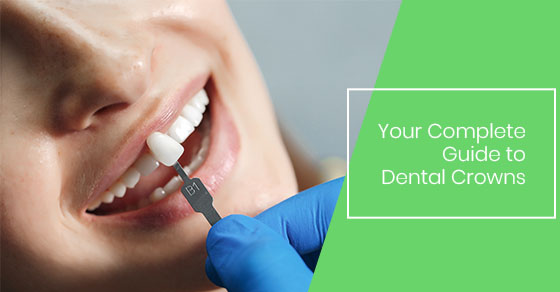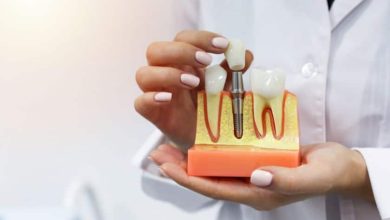What is Dental Crown And Bridge: A Complete Guide to Restoration

A dental crown and bridge is a dental restoration that replaces missing teeth by attaching artificial ones to surrounding teeth or dental implants. It improves the appearance, function, and alignment of the teeth.
A dental crown is a tooth-shaped cap that covers a damaged tooth, while a dental bridge is a set of artificial teeth supported by adjacent natural teeth or implants. Both the crown and bridge are custom-made to match the color, shape, and size of the patient’s natural teeth, providing a seamless and natural-looking result.
With proper oral hygiene and regular dental check-ups, a well-maintained crown and bridge can last for many years, restoring both the aesthetics and functionality of the patient’s smile.

Credit: www.milltowndental.com
Dental Crowns: Understanding The Basics
Dental crowns are custom-made caps that are placed over a damaged tooth to restore its size, shape, strength, and appearance. They are often used in situations where a tooth is severely decayed, fractured, or weakened.
Dental crowns work by covering the entire visible portion of the tooth above the gumline. The tooth is prepared by removing a small amount of enamel to make room for the crown. Once the crown is placed, it provides a protective covering for the damaged tooth, preventing further deterioration and restoring functionality.
- Restores the appearance of a damaged tooth
- Strengthens and protects a weakened tooth
- Improves biting and chewing ability
- Enhances overall oral health
- Long-lasting and durable
| Type | Materials | Advantages |
|---|---|---|
| Porcelain-fused-to-metal | Metal framework with porcelain overlay | Strong and natural-looking |
| All-ceramic | Ceramic material | Highly aesthetic and metal-free |
| Metal | Various metals, such as gold or silver | Exceptionally durable and long-lasting |
Dental Crown Materials
When it comes to dental crown materials, there are several options available to choose from:
Porcelain Crowns
Porcelain crowns are known for their natural-looking appearance. They can match the color and texture of your existing teeth, providing a seamless blend. These crowns are typically recommended for the front teeth.
Ceramic Crowns
Ceramic crowns also offer a natural appearance and are stain-resistant. They are highly durable and can withstand the forces of biting and chewing. These crowns are suitable for both front and back teeth.
Metal Crowns
Metal crowns, such as those made from gold or silver alloy, are incredibly strong and long-lasting. They are suitable for the back teeth where appearance is less of a concern.
Porcelain-fused-to-metal Crowns
Porcelain-fused-to-metal crowns combine the natural look of porcelain with the strength of metal. These crowns are a popular choice due to their versatility and durability.
Zirconia Crowns
Zirconia crowns are known for their excellent strength and durability. They are resistant to chipping or cracking and can provide a natural appearance. These crowns are suitable for both front and back teeth.
Dental Crown Placement Process
A dental crown is a restorative dental treatment that is used to restore the shape, size, and strength of a damaged tooth. The placement process typically involves several key steps:
- Initial Consultation and Examination: During the initial consultation, the dentist will examine the tooth that requires a crown and discuss the treatment plan with the patient.
- Tooth Preparation: The dentist will start by preparing the tooth by removing any decay and shaping it to accommodate the crown.
- Impressions and Temporary Crown Placement: An impression of the prepared tooth is taken to create a mold for the fabrication of the permanent crown. In the meantime, a temporary crown is placed to protect the tooth.
- Laboratory Fabrication of the Permanent Crown: The impressions are sent to a dental laboratory, where skilled technicians create the permanent crown to match the patient’s natural teeth.
- Final Crown Placement: Once the permanent crown is ready, it is placed and carefully adjusted by the dentist to ensure a proper fit and bite.
Dental Bridges: An Overview
A dental bridge is a fixed dental restoration used to replace one or more missing teeth. It consists of two or more crowns on either side of the gap, known as abutment teeth, with a false tooth or teeth in between, called pontics. There are different types of dental bridges, including traditional bridges, cantilever bridges, and Maryland bridges.
Dental bridges work by using the support of the adjacent teeth to anchor the pontics in place. The abutment teeth are prepared by removing a portion of enamel to make room for the crowns. The pontics are then placed in the gap, creating a seamless appearance and restoring the function and aesthetics of the missing teeth.
One of the main benefits of dental bridges is the improvement in chewing and speaking abilities. They also help maintain the structure of the jaw and prevent surrounding teeth from shifting. Additionally, dental bridges can enhance the appearance of your smile and boost your self-confidence.
Dental Bridge Materials
Dental bridges are an effective solution for replacing missing teeth. They are fixed prosthetic devices that are cemented onto adjacent teeth or implants, providing support and restoring the functionality and aesthetics of your smile. There are different types of dental bridges available, each made from different materials. Traditional dental bridges are the most common type and are composed of a false tooth (pontic) held in place by dental crowns placed on either side of the gap. These crowns are custom-made to match the shape and color of your natural teeth. Cantilever bridges are used when there is only one adjacent tooth available for support. Maryland bridges, on the other hand, are held in place by a metal or porcelain framework bonded onto the backs of adjacent teeth. Lastly, implant-supported bridges use dental implants as the foundation for the bridge, providing stability and durability. Your dentist will help determine which bridge material is best for your specific situation.
Dental Bridge Placement Process
A dental bridge is a type of dental restoration that is used to replace a missing tooth or multiple teeth. The placement process typically involves several steps to ensure a successful outcome.
Assessment and treatment planning: Before the bridge can be placed, a thorough assessment of the patient’s oral health is conducted. This may include X-rays, impressions, and a discussion of the desired outcome. During this stage, the dentist will determine if a bridge is the right solution and develop a treatment plan.
Tooth preparation and impression: The teeth adjacent to the missing tooth or teeth are prepared by removing a small portion of enamel to create space for the bridge. Impression of the teeth is then taken, which will be used to create a custom bridge that fits perfectly.
Temporary bridge placement: While the permanent bridge is being fabricated in a dental laboratory, a temporary bridge is placed to protect the prepared teeth and maintain the patient’s ability to chew and speak.
Laboratory fabrication of the permanent bridge: The impression taken earlier is sent to a dental laboratory where skilled technicians create the permanent bridge. This process may take a few weeks.
Final bridge placement: Once the permanent bridge is ready, the temporary bridge is removed, and the permanent bridge is carefully fitted and bonded onto the prepared teeth. The dentist will ensure that the bite feels comfortable and make any necessary adjustments.
| Assessment and treatment planning | Tooth preparation and impression |
| Temporary bridge placement | Laboratory fabrication of the permanent bridge |
| Final bridge placement | |
Dental Crown And Bridge Comparison
Dental crowns and bridges are common dental solutions for restoring teeth. While they have some similarities, they also have key differences. Here are the important factors to consider when choosing between a dental crown and bridge:
| Similarities | Differences |
|---|---|
| – Both dental crowns and bridges are fixed prosthetic devices | – Dental crowns are used to cover a damaged or decayed tooth, while bridges are used to replace missing teeth |
| – They can improve the appearance, function, and strength of your teeth | – Dental crowns require the reshaping of the tooth, while bridges rely on adjacent teeth for support |
| – Both can be made from materials such as ceramic, porcelain, or metal | – Dental bridges involve multiple crowns connected together |
| – They are custom-made to fit your mouth | – Dental crowns are individually placed, while bridges are fixed to adjacent teeth |
| – Both procedures require multiple visits to the dentist | – Bridges require more extensive preparation and may involve more discomfort |
Maintenance And Aftercare
- Brush your teeth at least twice a day with a soft-bristle toothbrush.
- Use a fluoridated toothpaste to help prevent tooth decay.
- Floss daily to remove plaque buildup between the teeth and along the gum line.
- Consider using an antimicrobial mouthwash to reduce bacteria in the mouth.
- Visit your dentist regularly for professional cleanings and check-ups.
- During these visits, the dentist will inspect your dental crown and bridge to ensure they are in good condition.
- Any issues or concerns can be addressed and treated promptly.
| Issue | Troubleshooting |
|---|---|
| Loose crown or bridge | Contact your dentist for evaluation and repair. |
| Tooth sensitivity | Use desensitizing toothpaste and discuss with your dentist. |
| Pain or discomfort | Contact your dentist to determine the cause and appropriate treatment. |
Frequently Asked Questions Of What Is Dental Crown And Bridge
How Long Do Crowns And Bridges Last?
Crowns and bridges typically last for many years with proper care and maintenance. They can often last up to 15 years or even longer, depending on various factors like oral hygiene, bite force, and regular dental check-ups.
What Is Better Bridge Or Crown?
A bridge is better when you have a missing tooth that needs support from adjacent teeth. A crown is better when you want to protect a weakened tooth from further damage.
What Are The Disadvantages Of A Crown And Bridge?
The main disadvantages of a crown and bridge include potential tooth sensitivity, decay or gum disease under the restoration, and the need for replacement over time due to wear and tear. It is crucial to maintain proper oral hygiene and visit your dentist regularly for check-ups.
What Is More Expensive A Crown Or A Bridge?
A crown is generally more expensive than a bridge.
Conclusion
Dental crowns and bridges offer effective solutions for restoring damaged teeth and improving your overall oral health. With their ability to enhance the appearance and functionality of your smile, these dental treatments have become popular options for many people. By understanding the benefits and process of getting dental crowns and bridges, you can make informed decisions about your oral care.
Don’t let dental issues hinder your confidence, explore the possibilities of dental crowns and bridges today.





